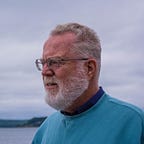146, Life, October, 2014
I don’t understand life — the hummingbird at our feeder, the urchins in our Bay, the pine pumping sap fifty feet high to support a bald eagle — it is all a full-of-wonders mystery to me. And yet, as Susan struggles for breath I find myself reflecting more and more on life: what it is, and what it might be to loose it. Not being a biologist or a physician my thoughts are unencumbered by knowledge, just the reflections of an old man.
The first image that comes to mind is Michelangelo’s “Creation of Adam” on the ceiling of the Sistine Chapel — a magnificent conception of a deity passing the spark of life to mankind.
Of course, there would have to BE a deity for such a concept to be of much worth and….
Still, I like the animating sense of linkage, of touching. It would seem to suggest that death might be a similar moment of withdrawing the spark. “God in His infinite wisdom” and all that.
My own conjecture is different. It is set long ago, perhaps around volcanic vents deep in the ocean. Complex molecules such as amino acids mingling and co-mingling, twisting back and forth on themselves until they began to produce an internal cohesion. More mingling and co-mingling until they acquire the ability to pass their energy on and to mutate. Which is to say, I imagine life to be a force field — a bit like gravity or some other attraction, in this case, primarily chemical. So, instead of Michelangelo’s majestic vision, I see a double helix of coiled energy.
This sense of energy within is not a new idea. One of its earliest expressions was by the pre-Socratic philosopher, Heraclitus. You perhaps know him from the oft-quoted, “You can never step into the same river twice,” which speaks to the ever-changing nature of our world. More subtly, he saw the world of apparent stability as masking a (balanced) inner tension, (He uses the simile of a strung bow.), an energy capable of projecting force beyond itself.
“All things are in flux; the flux is subject to a unifying measure or rational principle. This principle (logos, the hidden harmony behind all change) bound opposites together in a unified tension, which is like that of a lyre, where a stable harmonious sound emerges from the tension of the opposing forces that arise from the bow bound together by the string.” ―Heraclitus.
You and I, dear reader, are the most complex bundles of energy yet evolved on this planet. (I say “yet” because there are surely more to come.) The balanced tension — the complexity of the hummingbird, the urchin, the pine tree — pales when compared to our 86 billion neurons packed into just over the volume of a quart, (And you thought your IPhone was impressive!), folding and re-folding upon themselves to create virtually incalculable linkages.
We are, I think, complex, tensioned bundles of energy like Heraclitus’ bow. It is that coiled energy that we call life and that, in its infinite complexity, makes each of us the unique person we are. There will never be another self-tensioning combination quite like you or me or (more to the point) like Susan.
But, as it happens (further wonder) we are capable of blending, folding, complexifying our energy with that of another to produce a new, different, independent bundle of energy. And, (in spite of my philosophic bumbling), Susan and I have managed to send two bundles named “Rick” and “Matt” to the future.
I imagine death to be the releasing of Heraclitus’ tension, the relaxing of the bow whose internal dynamic has been part of us each from the beginning and which comes, in fact, as a “release”.
Given Susan’s present suffering, I like that thought. Not that she will live on to watch us “from above”, but that the natural tension that is life will be released and she will dissolve like a dream into her component parts — which are nothing without the tension that formerly united them.
Except, in their moment, they managed to create, to achieve, to laugh and cry and hope.
Heraclitus believed that opposites are necessary for life, but that they are unified in a system of balanced exchanges. The world itself consists of a law-like interchange of elements. The world is not to be identified with any particular substance, but rather with an ongoing process governed by a law of change.
If objects are new from moment to moment so that one can never touch the same object twice, then each object must dissolve and be generated continually. It follows that an object is a harmony between a building up and a tearing down. Heraclitus calls the oppositional processes “strife”, and hypothesizes that the apparently stable state, or “justice,” is a harmony of it: “We must know that war is common to all and strife is justice, and that all things come into being through strife necessarily.”
As Diogenes later explains: “All things come into being by conflict of opposites, and the sum of things, “the whole”, flows like a stream.”
In the bow metaphor Heraclitus compares the resultant balance to a strung bow held in shape by an equilibrium of the string tension and spring action of the bow: “There is a harmony in the bending back as in the case of the bow and the lyre.”
Think of that stationary pine, the one with the eagle in its top branches. Think of the dynamism it hides: of the flowing sap, the grasping roots, the lifting limbs. The law of change will bring it down, as it will us. But until it does, let us stretch as high and as far as we can. Let our stability conceal tensions and hopes and a hunger for new challenges.
